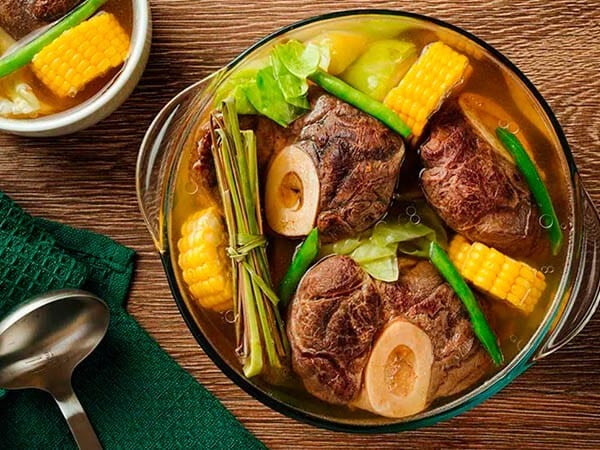Authentic Filipino Food Recipes to Try in the house
Checking out genuine Filipino food dishes provides a chance to appreciate the detailed flavors and cultural importance behind each recipe. From the well-loved Adobo, with its savory sauce, to the appetizing Sinigang that personifies the essence of Filipino convenience, these recipes welcome a much deeper understanding of traditional cooking practices. Making use of fresh, regional components is important, as is embracing common dining-- a trademark of Filipino society. As we think about the essential elements and techniques that define these cooking treasures, one may question what certain recipes can genuinely record the heart of this vibrant food.
Popular Filipino Dishes
Filipino cuisine boasts an abundant tapestry of tastes and traditions, with over a dozen famous recipes that highlight the country's diverse cultural impacts. One of one of the most popular recipes is Adobo, a full-flavored stew generally made with chicken or pork, marinated in vinegar, soy sauce, garlic, and spices. Its tasty taste account makes it a staple in Filipino families.
One more precious dish is Sinigang, a sour soup frequently made with tamarind, tomatoes, and different vegetables. This meal can feature pork, shrimp, or fish, and its rejuvenating preference is perfect for warm climates. For those with a pleasant tooth, Leche Flan-- a creamy caramel custard-- acts as a preferred treat, showcasing the Filipino fondness for abundant, pleasant tastes.
Kare-Kare, a hearty oxtail stew with a thick peanut sauce, along with the legendary lumpia, or springtime rolls, even more exemplify the selection located in Filipino cuisine. Each meal not just supplies special preferences however additionally tells a story of regional components and historic influences, making Filipino food a dynamic representation of its culture and heritage.
Necessary Components for Filipino Food Preparation
The significance of Filipino cooking hinges on its important ingredients, which act as the foundation for the country's cherished recipes. A selection of flavors and structures collaborated, showcasing the varied social impacts that shape Filipino food.
Secret ingredients consist of rice, the staple that goes along with nearly every meal, signifying nourishment and community. Soy sauce, vinegar, and fish sauce (patis) are essential for flavoring, imparting umami and deepness to meals. Fresh herbs like cilantro and basil add aromatic freshness, while garlic, onion, and ginger provide a durable flavor base.
Healthy protein resources such as pork, chicken, and seafood are central to many recipes, frequently marinaded to boost taste. Vegetables like eggplant, bitter melon, and green beans add necessary nutrients and equilibrium - Filipino food recipes. Coconut milk is one more substantial active ingredient, providing creaminess and a refined sweet taste to various stews and treats
Finally, calamansi, a citrus fruit, uses a revitalizing tang that boosts meals and beverages alike. With each other, these components create the lively and abundant tapestry of tastes that define Filipino food, making it both reassuring and distinct. Comprehending these principles is crucial for any individual looking to replicate genuine Filipino recipes in the house.
Step-by-Step Dish Guide

Begin by preparing your components. For Adobo, cut the meat right into consistent pieces and marinate it in soy sauce, vinegar, garlic, and bay leaves for a minimum of thirty minutes. Next off, warmth oil in a pan and sauté the garlic and onions up until aromatic, then include the marinated meat, allowing it to brownish uniformly.
For Sinigang, start by boiling water in a pot and adding your selection of meat. Once tender, include tamarind paste or fresh tamarind for that signature sour flavor. Adhere to with veggies like radish and kangkong, food preparation until just tender.

Tips for Genuine Flavor
Typically, accomplishing genuine flavor in Filipino dishes rests on the careful option and treatment of components. Start with fresh, premium produce, as the vibrancy of vegetables and natural herbs considerably enhances the recipe's overall preference. Staples like garlic, onions, and ginger form the fragrant structure for numerous dishes; utilizing them in proper percentages is critical.
Picking the right protein is just as essential. Typical adobo typically utilizes hen or pork, seasoned to soak up the marinate's full flavor. In addition, take into consideration sourcing in your area created or local components, as they can give authenticity that store-bought choices lack.
Cooking strategies additionally play a vital role. Slow-cooking techniques, such as braising or stewing, permit flavors to meld beautifully, while frying can add a gratifying texture. Do not ignore flavoring; using salt, fish sauce, or soy sauce at the appropriate moments can raise a meal considerably.
Offering and Appreciating Filipino Food
Cooking experiences are enriched when Filipino food is offered with interest to custom and community. The method of sharing dishes is central to Filipino society, symbolizing unity and hospitality. When offering Filipino dishes, take into consideration utilizing typical serveware, such as clay pots or bamboo baskets, which improve the credibility of the experience.
Typically, Filipino dishes are enjoyed family-style, with a range of meals placed at the facility of the table. This communal strategy urges communication and enables guests to sample various tastes. A well-curated spread may consist of staples like adobo, sinigang, and lumpia, complemented by rice, which is an essential part of every meal.
Accompanying the food with standard dressings, such as soy sauce, vinegar, or chili paste, can boost the dining experience, inviting diners to personalize their plates to their preferences. Additionally, integrating regional drinks, like calamansi juice or tuba, can enhance the overall taste profile.
Verdict
